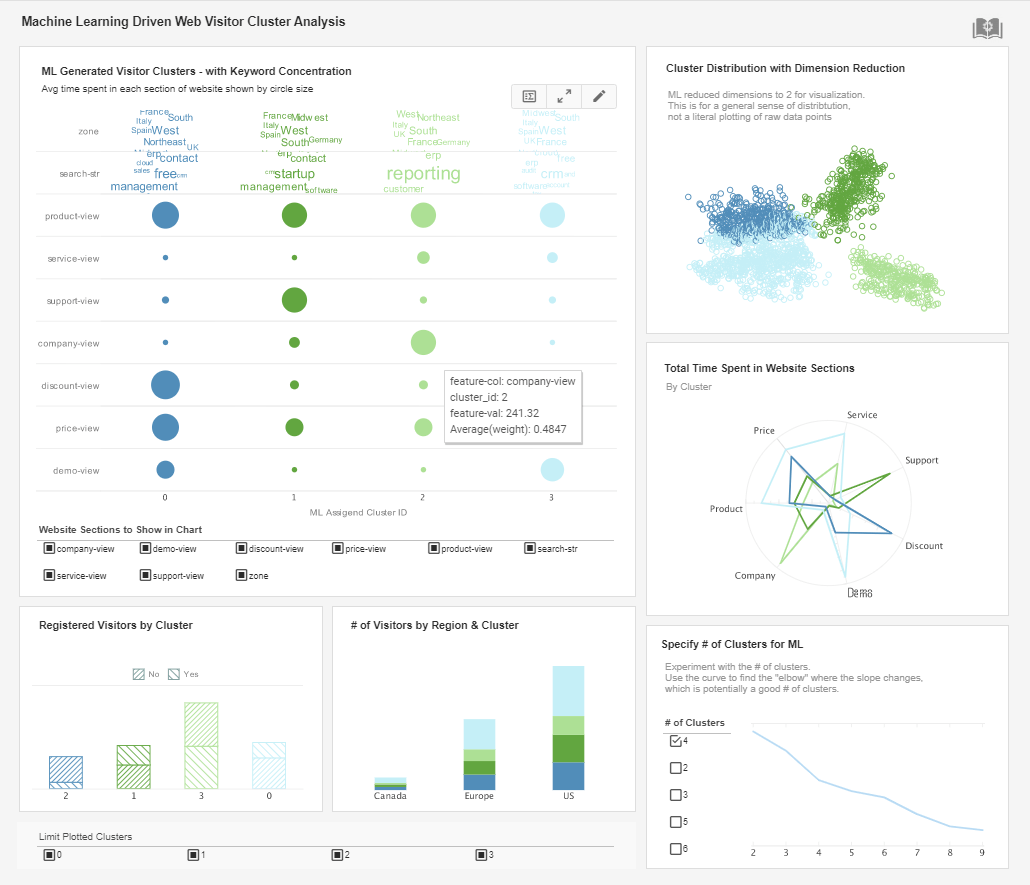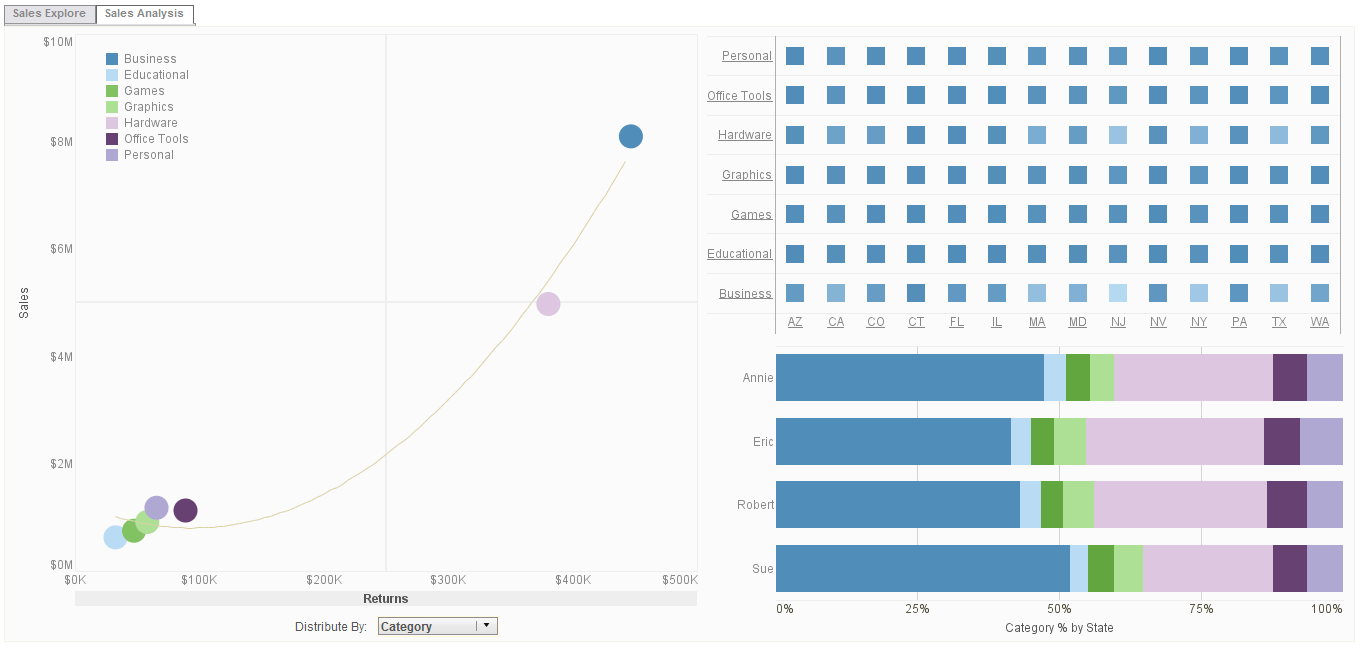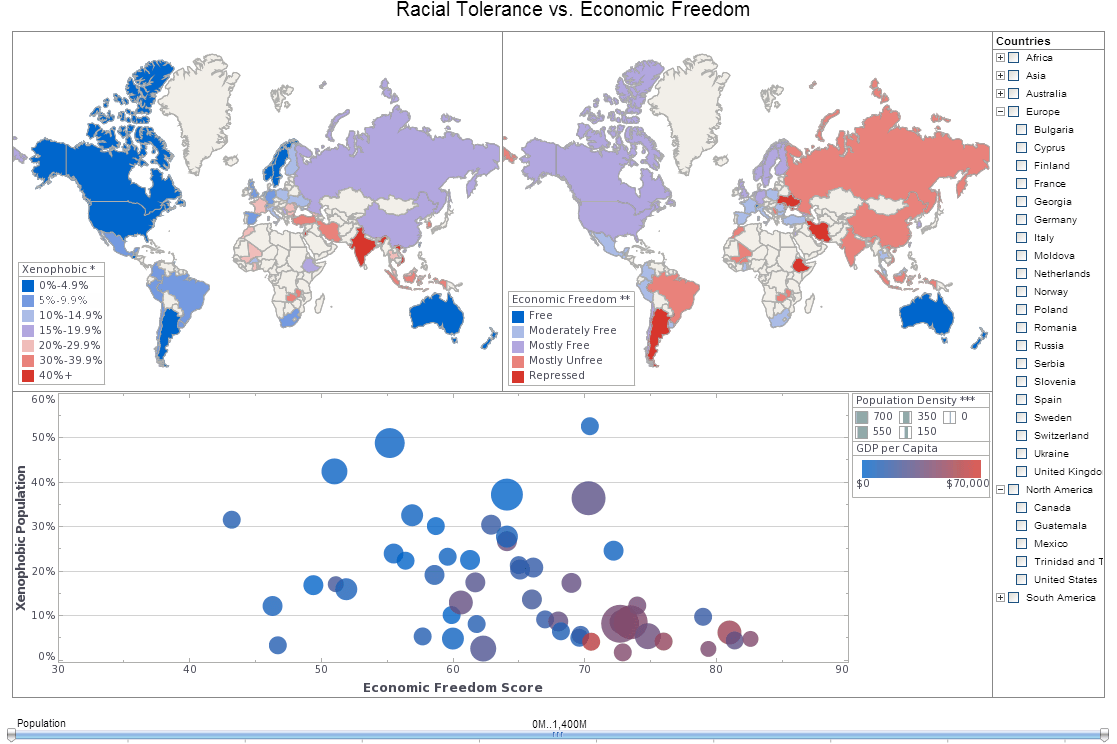Machine Learning Project Ideas
Looking for machine learning project ideas? InetSoft is an industry pioneer providing easier, more cost-effective business software solutions. Request a personalized demo.
What Are the Most Transformative Machine Learning Applications - Where are we witnessing the most transformative level of innovation in machine learning applications? The deep learning revolution started out in the image processing space. It has since branched into video. It has branched into speech recognition and audio processing because the improvements on all new processing and quality on your mobile phones are largely driven by deep learning techniques that came into widespread use two years ago or so. They are now increasingly being applied to natural language processing with very good results. I think the next frontier for the deep learning and machine learning revolution is to also upset this status quo on reasoning and logical conclusions. This is an area where the rule based systems -- best solutions for things like natural language processing or image processing before still reign supreme. We're at the next wave of deep learning based technology. It is very likely to also bring in and drive substantial improvements and assumption that help us address completing more use cases. I would definitely be reasoning as the next big frontier of what deep learning research can help deliver. Which industries will be most impacted by these developments? Looking at multiple consulting studies on this, what they all have in common is that they are from the past. They show a landscape of impacts all over the map. What seems to be different in how ML impacts these industries? For some it's the change in the core product or service that they are offering, like automotive manufacturers going to become self-driving car manufacturers...
What Are Some Settings for Applying Machine Learning - Another setting for applying machine learning is the science in genetics. A lot of genetics research is done on fruit flies, and the reason is they are convenient. They breed fast, and a lot is already known about the genetics of fruit flies. The MNIST database of handwritten digits is the machine learning equivalent of fruit flies. It is publicly available. (See the Wikipedia article on the database to learn more about it https://en.wikipedia.org/wiki/MNIST_database) We can get machine learning algorithms to learn how to recognize these handwritten digits quite quickly. So it's easy to try lots of variations, and we know huge amounts about how well different machine learning methods do on MNIST. And in particular, we know that the different machine learning methods were implemented by people who believed in them, so we can rely on those results. So, for all those reasons, we are going to use MNIST as our standard task. Here is an example of how it would be used. Of all the handwritten digits in MNIST, these are ones that were correctly recognized by a neural net the first time it saw them, but there are ones were the neural net wasn't very confident about. It could be a collection of digits that look like the number 2...
What Is the Difference between AI and Machine Learning - A set of buzzwords we are starting to hear every day is Artificial Intelligence (AI) and Machine Learning (ML). In addition to the vast business potential of these technologies, the more popular take for most people is perpetrated by the entertainment industry, which has us all thinking of what could happen if AI or ML equipped devices became self-aware. This is by no means a new fear. In 1927, Fritz Lang's film Metropolis effectively expressed the fear that the society of his time had for thinking machines. More disturbing portrayals showed in both 1984's The Terminator and 1999's The Matrix giving a chilling picture of what might happen if these autonomous digital minds were able to take over completely. Much of this fear is grounded in the definitions of the two tools: AI refers to when non-human systems utilize cognitive functions such as learning and problem solving. While Machine Learning has powerful computers sorting through massive amounts of data and extrapolating probabilities from there. The implications of this technology has wide-reaching promises for business and daily life, but the chance of us bowing to computer overlords is more remote than Hollywood would like to make it seem...
What is the machine learning algorithm used in this churn case study - This post is the fifth in a series discussing a machine learning use case for a mobile app provider. The link to the full case study can be found at the end of the post. The first post can be found at https://www.inetsoft.com/blog/machine-learning-concepts-defining-churn-predictive-metrics/ This sounds like an intimidatingly technical topic to someone who is not a data scientist, but in fact, it's not hard for business people to understand the concepts of the various algorithms used in machine learning basics. You could treat machine learning as a black box where you do not even know what it is using inside to give you the best answer, but it is rather useful to know what the black box can do for you. Actually, the black box approach and software advancement has begun to allow non-technical users like marketers to do self-service machine learning experiments. A basic understanding allows a business person to map tasks on hand on to the type of machine learning algorithm to experiment with. It also allows effective collaboration with data scientists or data engineers. This particular machine learning churn case study utilizes an algorithm called a gradient boosted decision tree. Decision tree algorithms belong to a type of machine learning algorithm called "classification". Classification, like the name implies, classifies each observation into a predefined class. In this use case, it assigns a user into one of two "churn" classes. In the model training step, business users first label a set of users into the churn classes, and then let the machine learning algorithm study the data set to figure out how to do the same classification automatically. Classification falls under a category called supervised learning since the training dataset is coded with the answers by a supervising human. There are many algorithms within the classification category. The choice of which classification algorithm to use is typically done through iterative experimentation picking the one with the highest accuracy rate. Machine learning is a wide field even for technical oriented people. But for common business applications, most frequently used algorithms concentrate in a few categories. Some are useful for business applications but are not as accessible. In other words, they require elaborate technical infrastructure and/or deep technical expertise to apply. The next few machine learning primer articles will focus on accessible, business application oriented algorithms...
What Is Machine Learning Operations? - To guarantee that machine learning models can be deployed, monitored, and maintained at scale, the technique of "machine learning operations" (MLOps) integrates machine learning with DevOps. MLOps gives businesses end-to-end visibility into the machine learning lifecycle while automating processes to streamline the entire machine learning pipeline, from development to deployment. We will go through the definition of MLOps, its advantages, and some best practices for using it successfully in this post. To guarantee that machine learning models can be deployed, monitored, and maintained at scale, the technique of "machine learning operations" (MLOps) integrates machine learning with DevOps. MLOps offers enterprises a platform for quickly developing, evaluating, and deploying machine learning models. Moreover, it makes it possible for businesses to manage machine learning models as they change over time. Data preparation, model training, testing, deployment, and monitoring are just a few of the tasks involved in MLOps. It makes use of the DevOps tenets of continuous integration, continuous delivery, and continuous deployment to automate these processes and guarantee their efficient and reliable execution...
When Do You Need a Data Scientist for ML - This post is the ninth in a series discussing a machine learning use case for a mobile app provider. The link to the full case study can be found in the first post of this series: https://www.inetsoft.com/blog/machine-learning-concepts-defining-churn-predictive-metrics/ We end this series of informational posts with a question: When do I need a data scientist? To get started and to experiment with machine learning, in marketing or any business function, you do not need a data scientist. You just need to be as skilled as an Excel power user, someone who knows the data and is comfortable doing analytics. When you define the business goal, the conceptual knowledge you possess so far on machine learning from reading our series of articles should allow you to decide which class of machine learning algorithms to look at. With a proper software tool, experimenting with a small dataset is becoming more and more practical. As mentioned previous post, you can even just start with your PC. And as mentioned before, beyond the type, you don't need to understand much what the algorithm is doing. With just trial and error you can see which of the models gives the best accuracy. When you've identified the best model and its fit is over 70%, then it is worth planning on putting it into production. And that is the right time to engage with a data scientist and your IT support staff to fine tune things and take the necessary steps to productionalize the model and the subsequent business actions it calls for. Also, if you can't manage to reach a worthwhile level of accuracy, that is another time to ask a data scientist for help, and learn what possible tricks they might have up their sleeves to augment the data or seek other models. If you're ready to embark on a machine learning project, and you'd like even more handholding, we are raising our hand. Our software makes it as easy as possible to run machine learning models, and an InetSoft data scientist will be assigned to help...
When to Solve Business Problems with ML - Where is machine learning being leveraged to help solve real business problems nowadays? We see a few main areas where enterprises are looking for business value and business benefits and applying machine learning to their daily operations. The first category is a top line growth. This is about serving better recommendations to customers, finding the right customers, finding the right opportunities, approaching them in the right way and upselling and cross-selling in order to drive the top line. Recommended systems is primarily a domain of natural language processing, of sales cycle, sales insight systems, as well as marketing optimizations. The second big area is to help re-imagine business processes with digital intelligence. So this is not just about redoing what we do today with ML insight but about truly rethinking the end-to-end process in a way that this leverages ML capability to deal with the routine and the optimal current cases, and this can have tremendous bottom line benefits. The third category is about employee engagement and having healthier and more satisfied employees with a more varied set of challenges during their working hours because again they can focus on the top and to the underserved cases that require new thinking and that require unstructured problem solving. This also includes automating away some of the mindless or repetitive tasks that nobody particularly enjoys about their daily activities today...
Why Machine Learning Still Has Human Bias - So let me just give you one or two examples of why that frankly is not good guidance. The first is you have to select the data set that you're going to use. With the machine-leaning technique, human bias is front and center. What do you select? The second is you need to select a machine-learning technique against the data that you now selected, right? That is point of human bias number two right. Then three, just to make it a nice round number is you then have to basically interpret and tweak the output. In many cases in machine-learning, a technique is actually used. What is the point of bias number three? You can't remove human bias from this, simply because you're throwing around the marketing term, visioneer, which is machine-learning right. And it's kind of just front and center of having some basis about what your claiming to understand. It stirred things up to be that declarative about why that was not terribly the best guidance. Ultimately what was interesting is that the people involved tried to turn it into me being you know not a nice guy because I pointed out some facts here. They never ever actually push back on the idea that you know what they said was not correct. The reason for bringing this up is that anyone that makes assertions in this space that is unwilling to engage on their assertion or provide evidence for what they say is probably someone that doesn't know what they're talking about. You need to look at things people say very carefully whether it's us or it's other people in the space, consultants you or software sellers, anyone that makes assertions or claims that are big and sweeping, and that are universal...
Why Is Machine Learning So Hot Now - Why is machine learning so hot now if I'm saying machine learning has been around since at least the 1950s? Why now? Why is it hyped now? I think there are a couple main reasons, one being just advances in technology and research. Of course, I mean computers are cheaper and more powerful. It was in 2006 that one of the first most important deep learning papers was published. There have been fundamental changes in research and technology that have gotten us here. Another thing is now we have the ability to store a lot of data and cheaply, and in general machine learning algorithms do better with a lot of data. That's not always true, but in general that is true. Another thing that's going on is there's business demand for machine learning, so things like text mining and recommendation systems. There is demand within business to pay for these kinds of activities. These have led to the rise of data science and the data scientist. I consider myself a data scientist. Data scientists are likely when solving a problem to reach out to a machine learning algorithm as opposed to maybe just old fashion OLS regression or canonical discriminant analysis. What we're looking here at the screen is how the data scientist has long history going back to 1962, and we have some resources about this history. I just think it's important to keep in mind this history. This is something that's been building for a long time. A lot of factors have conspired to make it important and exciting now. All right, so let's focus on this data scientist persona and how that is affecting machine learning in organizations. Well, we definitely believe that machine learning is being taken more seriously as data science and data scientists are taking more seriously. There's a lot to unpack here, but we've seen over the past few years sort of a segmentation of data scientist where there's different types of data scientists, different levels of data scientists...
Why Your Business Needs Machine Learning - Machine learning, or ML, is an important advancement for businesses. Computers can now do some of the time consuming work that humans used to do. Those humans can now focus on other more complicated or high level work. It's a relatively new technology, but it's making an impact for all the right reasons. The main benefit of machine learning is that it can gather insights while collecting data and analyze it in depth. It can discover things in the data that people cannot. Which means it's beneficial from a time saving standpoint as well as the quality of insights it can derive. There's more to it than just analyzing data all day, the benefits are numerous and the possibilities seemingly endless...
Why Do We Need to Mash Up Machine Intelligence with Human Intelligence - This week Dow Jones published an interesting article about the limitations of machine learning and the need to supplement it with human intelligence. In fact, that's the inspiration of our tagline "Mashup Machine Intelligence with Human Intelligence." This article makes for good introductory reading on the topic of machine learning. It lists some common but very difficult applications of the technology such as detecting Russian spies or nude pics posted by an angry ex. For a more in-depth intro to ML for business users, see our series of posts starting with https://www.inetsoft.com/blog/machine-learning-concepts-defining-churn-predictive-metrics/ What may be surprising is the masses of humans now being employed to both assist in the training of ML models and to monitor and modify the output of ML predictions. A new industry has sprouted to offer home-based, world-dispersed workers to do some of this work. Facebook alone is having to significantly invest in staff to power its "artificial intelligence." The full article can be found here http://www.morningstar.com/news/dow-jones/us-markets/TDJNDN_20171112481/without-humans-artificial-intelligence-is-still-pretty-stupid.html As a provider of data intelligence software, our solution provides a visual approach to make it easy for non-data scientists to take advantage of machine learning. It integrates business intelligence analytics and model training in one application so you can more easily understand what the model is saying...





